 |
||
|
||
| ||
 Marketers often promise more than a real product turns to be equipped with. In video card market the promised features often become realized only in the next generation of video chips. What I mean is a shader support, which is absent in the GeForce2 though it carries the suffix GTS that means Giga-Texel Shader. Many will blame Microsoft which didn't want to realize the incomplete support of shaders in DirectX 8.0 (so called 0.5 version), that is why GeForce2 cards, now, haven't got any possibility to realize pixel shaders. But the software giant was right in its insistence to realize the complete support, since first of all it was important for developers: the usage of shaders must guarantee that the hardware will process everything correctly. You can see that with the release of new versions of GeForce2-series chips, the GTS suffix was changed to "Pro" and "Ultra" :-). Of course, it is a plain joke since the GeForce2 Pro is an extension of the GeForce2 GTS and gives more speed in 3D. We have already written about such cards and the chipset itself which is in fact the same GeForce2 GTS, but equipped with a faster memory. The GeForce2 GTS based cards differ from GeForce2 Pro ones only in their memory: the first have 166 (333) MHz with 6 ns access time, the latter ones have 200 (400) MHz memory with 5 ns access time. The GPU frequency remains the same - 200 MHz. Many manufacturers have already released cards based on this processor, one of such companies is Chaintech Computer from Taiwan. And today we are going to consider a relatively new product based on the NVIDIA GeForce2 Pro - Chaintech Desperado RI93. CardThe Chaintech Desperado RI93 card has AGP x2/x4 interface, 64 MBytes DDR SDRAM is located in 8 chips on the right side of the PCB. 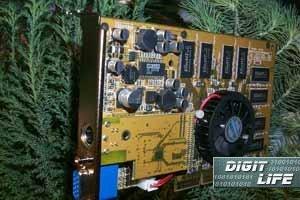 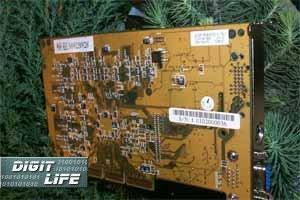
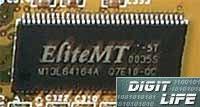 EliteMT produces memory chips with 5 ns access time which corresponds to 200 (400) MHz. We mentioned earlier that at the beginning of 2001 only Elite Semiconductor chips could work flawlessly at 200 (400) MHz, that is why all GeForce2 Pro cards were equipped exactly with this memory. Today some manufacturers are installing memory modules with 5 ns access time from other companies. But in overclockability the EliteMT chips are still above all. The card's design completely corresponds to the reference one from NVIDIA. The PCB is bright yellow (which is typical for Chaintech), and it has a daughter board with a TV-out. The latter is equipped with a S-Video connector, but the card is supplied with a S-Video-to-RCA adapter which means that if a S-Video connector is absent on your device, you can use a TV-out. The GPU is equipped with an active cooler of a roundish form with a very effective fan (the similar fans are installed on ASUSTeK cards). The card is shipped in a Retail-package (unfortunately, this sample was delivered in ╬EM-box). Inside the box you can find::
OverclockingThe Chaintech Desperado RI93 card has reached 220/235 (470) MHz. It is not a record, but it is not a bottom either. We are especially interested in memory overclocking since we have shown that even 250 (500) MHz frequency doesn't release the 200 MHz GeForce2 GTS processor from shortage of the memory bandwidth. That is why such increase of the memory (from 200 to 235 MHz) can show the whole GPU potential, even if it is not much overclocked (from 200 to 220 MHz). Installation and driversTest system configuration:
In our tests we used NVIDIA drivers of 11.01 version, VSync was off. For comparison we have taken the results of Hercules 3D Prophet II Pro (GeForce2 Pro), Leadtek WinFast GeForce2 Ultra cards. Test resultsAs for the 2D quality, there is nothing to complain about. The quality corresponds to the level of the GeForce2 Pro cards from brand-name manufacturers. But still note that 2D quality may greatly depend not only on a manufacturer but also on a definite sample. Besides, before you blame the video card check whether your monitor meets the requirements you are setting for your video card. The following programs were used to estimate the 3D quality:
Quake3 Arena
demo002The tests were carried out in two modes: Fast (shows card's work in 16-bit color) and High Quality (shows card's work in 32-bit color).  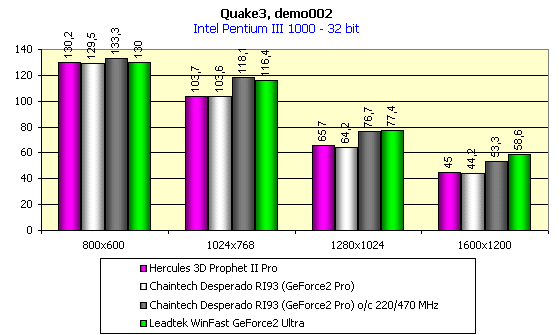 The Chaitech Desperado RI93 is at the same level with its competitor in the results, and when overclocked it is just as good as a more expensive card on the GeForce2 Ultra (except 1600X1200, where the latter takes the lead at the expense of the GPU frequency). ExpendableThe game is used to show the performance in the Direct3D. 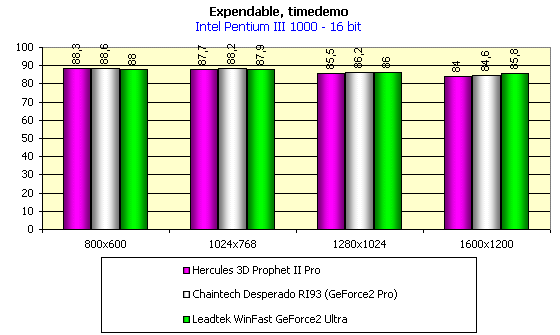 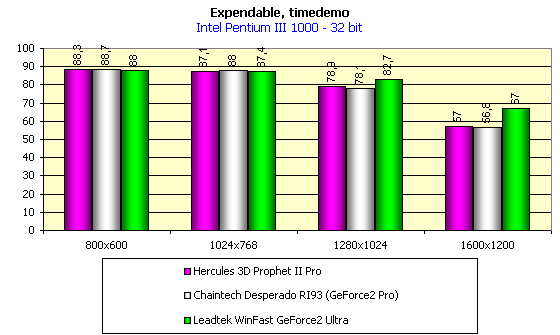 The situation is the same: the Chaintech Desperado RI93 shows the performance as high as that of the competitors. ConclusionMany times we have mentioned that the GeForce2 Pro based video cards are a better purchase than the cards on the GeForce2 Ultra due to a lower price for the former ones and an overprice for the latter. The price of the Chaintech Desperado RI93 is going to remain relatively lower than that of the competitors. Besides, I can recommend this card to those who, apart from high speed in 3D, need a TV-out. In our 3Digest you can find the comparison characteristics of cards of this and other classes. Highs:
Lows:
Write a comment below. No registration needed!
|
Platform · Video · Multimedia · Mobile · Other || About us & Privacy policy · Twitter · Facebook Copyright © Byrds Research & Publishing, Ltd., 1997–2011. All rights reserved. |